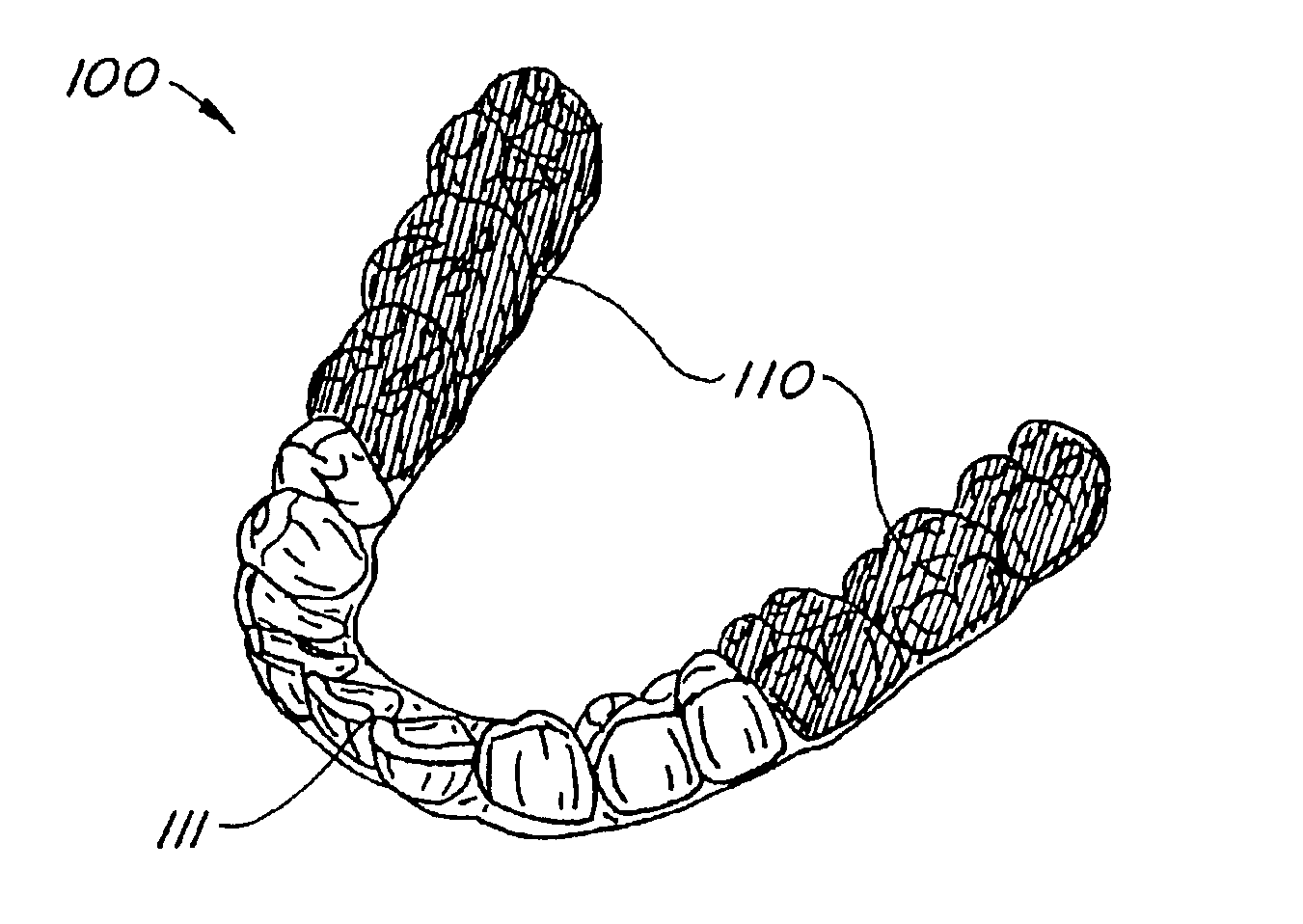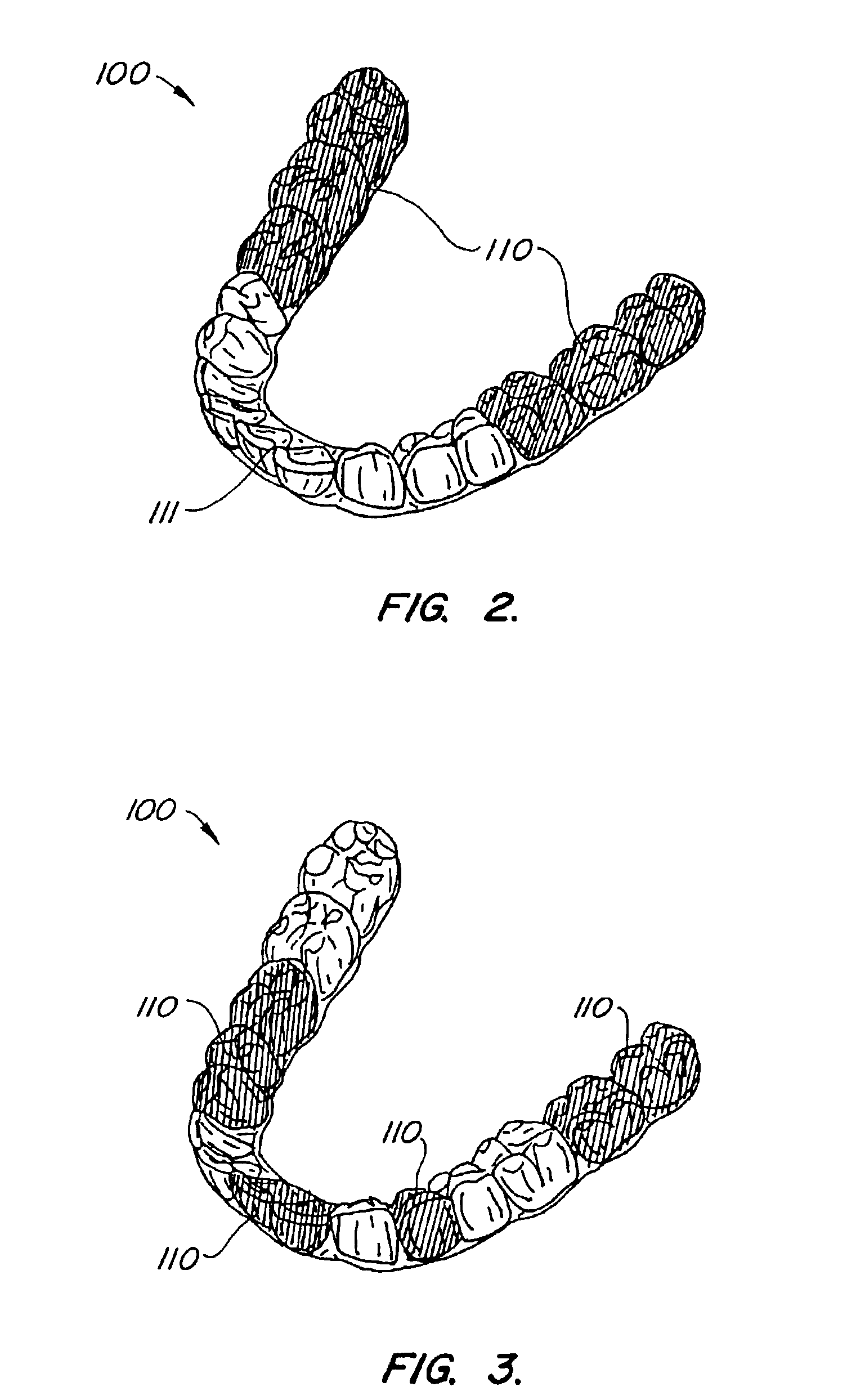[0013]The introduction of such portions or regions with more flexibility provides utility in ease of use for the patient. The patient may find ease in positioning the appliance with the more flexible portions first which may guide the appliance in placement of the more rigid, slightly misfit portions designed for repositioning. This sequence may be reversed in removal of the appliance. Likewise, such flexibility may also allow for any slight differences in mold versus appliance versus
dentition geometry which may otherwise make placement and removal of the appliance more difficult. In some cases, a generally misfit appliance may “pop off” or have a tendency to disengage even when properly positioned over the teeth. Increased flexibility may reduce these tendencies.
[0014]In further embodiments, portions of the elastic repositioning appliance may vary in elastic moduluses along different and / or additional axes. For example, moduluses may vary along a facial-lingual axis. Facial may be defined as next to or toward the lips or
cheek, including terms labial and buccal. Lingual may be defined as next to or toward the tongue. Thus, a facial-lingual axis may be described as an axis following a radial or similar line from the tongue toward the lips or
cheek and vice versa. Likewise, moduluses may vary along a gingival-crown axis. This may be described as a substantially
vertical axis following a line from the top of the crown at the edge of the
occlusal surface of a tooth toward the gingival line or root and vice versa. In a preferred embodiment, an appliance may have a portion with a lower
elastic modulus covering the occlusal surfaces of the teeth and a portion with a higher
elastic modulus covering the remaining surfaces of the teeth. Thus, the moduluses may vary along a facial-lingual axis and / or a gingival-crown axis, depending on the boundaries of the delineated portions. Such a design may incorporate added flexibility to the appliance while maintaining adequate repositioning forces in the most efficient areas.
[0015]In addition to varying in stiffness along the axes described above, the appliances of the present invention may vary in stiffness or
hardness over the “thickness” of the appliance. Usually, such variations and stiffness over the thickness will be accomplished by layering the device, i.e., with
layers of differing stiffnesses or hardnesses being placed successively over the mold used to form the appliances, as described in more detail below. Thus, the appliances may comprise shells having first and second portions, as generally described above, where each of those portions comprise
layers in a laminar structure. Usually, at least one of the first and second portions will comprise a continuous layer along the mesial-distal axis. The second and optionally additional layers may also be continuous along the mesial-distal axis, but will often be discontinuous, i.e., broken into two or more segments. Such layered devices can provide a variety of benefits. For example, layers formed from stiffer or harder materials can be used to more firmly engage teeth, while the less stiff or softer layers can be used to provide compliance and greater elasticity. In a particular preferred embodiment, the appliance comprises a discontinuous inner layer and a continuous outer layer. At least a portion of the inner layer is configured to engage individual teeth or groups of teeth and will be stiffer or harder than the outer layer. The outer layer, which is less stiff and therefore more compliant, provides the elasticity to move the teeth relative to one another, while the harder inner layer firmly engages the teeth to provide a better grip or anchor upon the teeth.
[0019]In an additional specific embodiment, one or more appliances may be produced with a suitably flexible
elastic modulus to receive and resiliently reposition teeth from an unprescribed arrangement to a prescribed arrangement. This might be necessary in cases of lowered
patient compliance. If a patient were to remove an appliance for an unintended and / or extended period of a prescribed
treatment time, the patient's teeth may move slightly out of the planned tooth progression. When attempting to reapply the appliance, an appliance which is too rigid may not be able to accommodate these slight differences. Thus, a more flexible appliance (but having an identical geometry) may be produced for this purpose and may be incorporated into the
treatment plan at any given point in the series of successive appliances. The ability to return to the same geometry is an
advantage because it minimizes the need to replan the
treatment protocol.
[0020]In a third aspect of the present invention, systems for repositioning teeth from an initial tooth arrangement to a successive tooth arrangement comprise a plurality of incremental elastic position adjustment appliances in which at least one appliance has the same shape yet different elastic modulus as an immediately prior appliance. In a specific embodiment, a series of incremental appliances may be produced with differing elastic moduluses to reposition teeth from an initial tooth arrangement to the next successive tooth arrangement in a progression of arrangements to the final arrangement. Each of the appliances in the series from the first to the next successive tooth arrangement may have the same shape or geometry since the
tooth movement represents one step in
tooth movement. However, the variance in elastic moduluses may allow for a larger step or increment in
tooth movement than may be obtainable with consistent, rigid appliances. For example, an appliance may be produced with a tooth arrangement which is substantially misaligned from the initial arrangement. High modulus appliances may not be flexible enough to allow the appliance to fit over the teeth in the initial arrangement. However, a series of appliances of the same shape may be produced with increasing elastic moduluses from relatively low to adequately high. The patient may begin with the lowest elastic modulus appliance which may be the most flexible to fit over the teeth. As the teeth are repositioned, the patient may successively utilize each appliance in increasing modulus until the teeth have conformed to the successive tooth arrangement. At that time, the patient may begin a new series of appliances with varying moduluses and a shape to reposition the teeth to the arrangement of the next step in the repositioning progression. The ability to reduce the number of different appliance geometries required for a single course of treatment can provide a significant reduction in planning effort and manufacturing costs.
[0022]Further, different elastic moduluses may be produced by forming selectively reinforced and / or composite-type materials. For example, a
polymer material may be reinforced with structures such as strips, wires, pieces, mesh, lattices, networks, and the like. These structures may be comprised of any suitable material, particularly metals and alloys but also including
polymer filaments, wires, braids, and the like. Likewise, composite materials may be comprised of interpenetrating polymeric networks. An interpenetrating polymeric network is comprised of a base material and an additional material that interpenetrates the base material to alter its mechanical properties. For example, the base material (A) may be a
solid polycarbonate. The added material (B) may be a
liquid polymer,
monomer or crosslinking agent which is allowed to interpenetrate and activate to form a composite network. The composite (A+B) may have a stiffness which is greater than the sum of its parts, (A) and (B). Further, another material (C) may also be allowed to interpenetrate and activate to form a new composite network. The composite (A+B+C) may also have a stiffness which is greater than the sum of its parts, (A), (B) and (C). With this method, any number of composites may be formed providing a wide range of mechanical properties, specifically stiffnesses. In addition, a number of these production methods may provide materials with gradual changes in elastic moduluses. For example, purposely irregular
coating of a
polymer material may provide higher stiffness in areas with thicker
coating and lower stiffness in areas with thinner
coating. This may be applied to a number of production methods.
 Login to View More
Login to View More 


